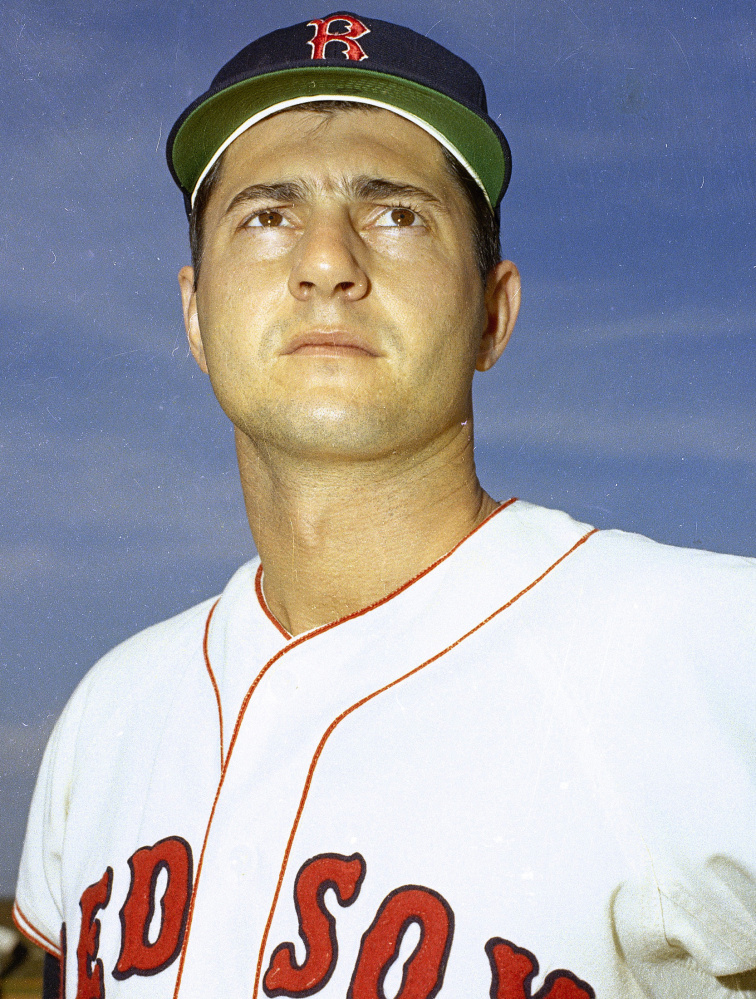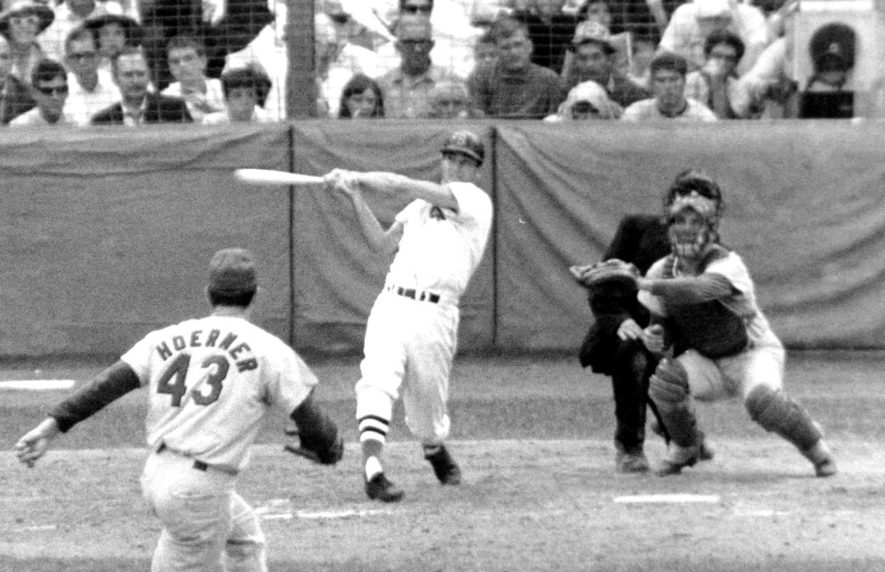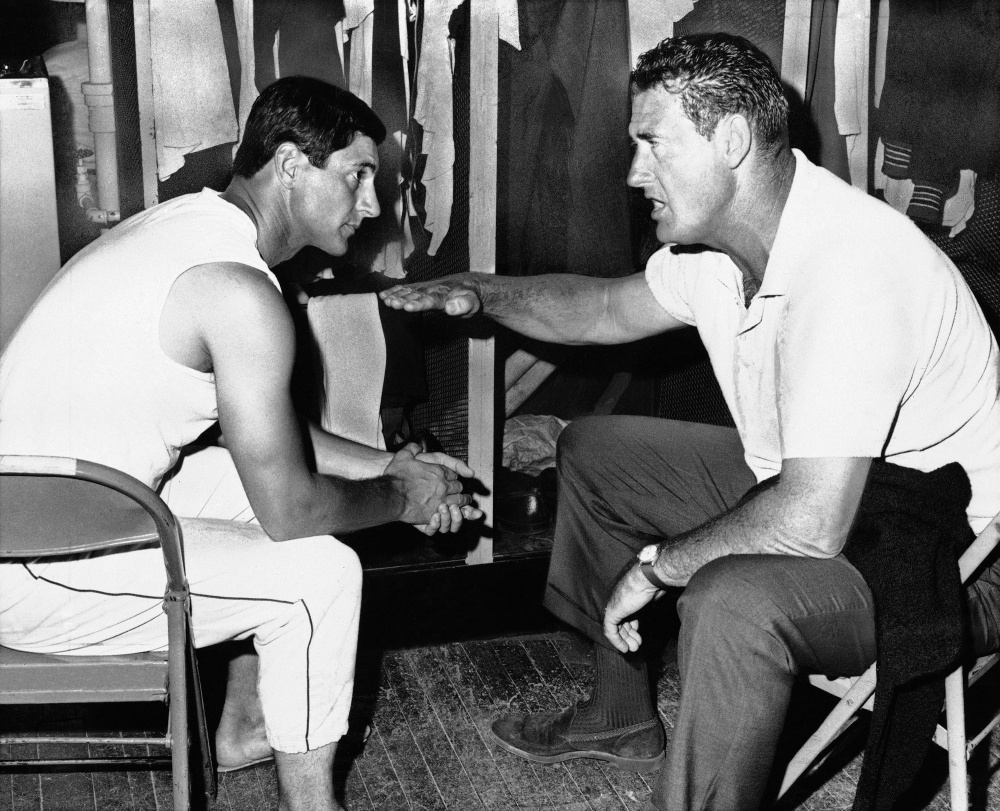Only an Impossible Dream could have relegated Carl Yastrzemski’s 1967 Triple Crown to a virtual footnote.
It was a dream realized, as the Yastrzemski-led Red Sox pounded life into a moribund franchise and won the American League pennant for the first time since 1946.
Yastrzemski, now 77, led the way with a virtuoso performance that – if only for one season – drew comparisons with Red Sox icon Ted Williams, who won the Triple Crown twice.
The 5-foot-11, 175-pound Yastrzemski did it by hitting .326, driving in 121 runs and tying Harmon Killebrew of the Twins with 44 home runs.
Now, 50 years later, Yastrzemski still gives scant attention to one of the greatest individual seasons in major league history.
“I never even thought about it, not at all, even during the season,” Yastrzemski said from south Florida, where the avid golfer spends his winters. “I think it’s because we finished last or next-to-last my first six years, then all of a sudden, to become involved in the pennant race, there was only one thing on your mind, and that was to try to help win a pennant. So I never thought about the Triple Crown. It was like a shock being in the pennant race.”
The Red Sox, Twins, Tigers and White Sox battled for the American League flag in what many called the best race in baseball history.
Orioles outfielder Frank Robinson won the Triple Crown in 1966, so Yastrzemski’s pursuit did not captivate fans the way it did 45 years later in 2012, when Miguel Cabrera of the Tigers won his Triple Crown in the era of wide television coverage and frenzied social media.
Yastrzemski didn’t see it coming, nor could anyone else. He had averaged fewer than 16 home runs his first six years. At 27, he already was a three-time All-Star and had won a batting title. But to Red Sox fans, he was not Williams.
“I went to spring training with the Red Sox in ’60 and I lockered next to (Williams),” Yastrzemski said. “I think he was 44 at the time. We had some great conversations. I was just always amazed at how big he was and the strength that he had. If I would hit a driver in golf, he’d hit a pitching wedge and hit it just as far. I just marveled watching him take batting practice.
“But it put a lot of pressure on me my first year up being compared to him. I knew myself that I could never be the hitter that he was. I knew that. I think my first couple months in the big leagues, I tried to change my style of hitting instead of hitting the way I did in the minor leagues. I tried to hit home runs, trying to be him. It finally dawned on me after a few months I couldn’t be him and never would be.”
Yastrzemski listened to what everyone said about hitting but didn’t necessarily take their advice. “Most of the time,” he said, “I tried to figure out everything myself.”
He often changed his batting stance, with his most distinctive version the one in which he held the bat high. “It wasn’t as high as people thought,” he said. “It was just ear level. At that time, it was higher than normal.”
In the winter before the 1967 season, Yastrzemski started to work out under physical therapist Gene Berde, who had been a member of the Hungarian Olympic boxing team, at the Colonial Resort in Wakefield, Massachusetts.
“It was a boxer’s workout. I would jump rope, do some wrist curls, things like that,” Yastrzemski said. “I did rope climbing. After the workout, I swung a leadened bat maybe a couple hundred times. I think I started to mature physically.”
And Yastrzemski’s teammates noticed. “Carl, to that point, had not been a Triple Crown threat,” former infielder Mike Andrews said from Jupiter, Florida. “He didn’t hit that many home runs. It was almost like the whole year, pitchers didn’t believe he was going to do it.”
Shortstop Rico Petrocelli agreed. “While I don’t recall anyone thinking Yaz had a chance for the Triple Crown, he showed great power after his workouts in the offseason,” he said from Nashua, New Hampshire. “If anything was close to the plate, he hit it solid somewhere. It was like the (1969) Miracle Mets. Every day somebody was doing something special, and Carl was doing it every day.”
But it was all about the pennant race. In 1966, the Red Sox finished ninth out of 10 American League teams, 26 games behind Baltimore. It was the fourth time in the previous five years that they had finished no higher than eighth. They hadn’t had a winning season since 1958 and had gone 574-703 (.449) from 1959-66.
But in the first three months of the 1967 season, they hovered around the first division and were only six games out of first place at the All-Star break.
The Red Sox won 10 straight games after the break and moved within a half-game of the lead, but on Aug. 18 outfielder Tony Conigliaro was lost for the season when a pitch by Jack Hamilton of the Angels fractured his left cheekbone, dislocated his jaw and, most significantly, damaged the retina in his left eye.
“I thought we would have had a shot (in the ’67 World Series, in which the Cardinals beat the Red Sox in seven games),” Yastrzemski said. “It could have been different if Conigliaro had been healthy.”
The regular season went down to the final weekend, with the Twins at Fenway Park, where the Red Sox drew more than a million fans that season for the first time in Yastrzemski’s career. The Red Sox trailed the Twins by one game with two remaining. The Triple Crown was back-burner talk, if at all. Yastrzemski and Killebrew were tied with 43 homers and Yastrzemski led Killebrew 115-111 in the RBI race. Yastrzemski was batting .319, Robinson .314.
In the Saturday game, Yastrzemski had three hits, including his 44th homer, a three-run shot into the right-field seats off reliever Jim Merritt in the seventh inning of a 6-4 victory.
“I said, ‘Wow, that’s hard to believe that happened,’ ” Merritt said from Hemet, California. “That’s one of those things that was meant to happen.”
Merritt said it didn’t occur to him that Yastrzemski had taken the home-run lead over Killebrew. “We were just trying to finish off the pennant,” he said.
In the ninth, Killebrew came up against Red Sox reliever Gary Bell. “I said, ‘I’ll just pitch around him,’ ” Bell said from San Antonio, Texas. “He hits it right over the fence. That ended up tying Yaz. He hit 573 of them, so I wasn’t the only one who gave up a homer to him.”
Bell didn’t feel he had disappointed Yastrzemski. “I don’t even recall that being an issue,” Bell said. “We were too worried about winning.”
On Sunday, the final day of the season, Yastrzemski went 4 for 4 as the Red Sox won 5-3 to earn at least a tie for the pennant at 92-70. The team stayed at Fenway listening on the radio as the Angels eliminated the Tigers by winning the second game of a doubleheader, which clinched the pennant for Boston.
Killebrew took no solace in denying Yastrzemski the outright home-run lead. “It was more disappointing to my dad losing the pennant,” said his son, Cameron, of his Hall of Fame father, who died in 2011.
Merritt agreed. “Harmon was a pro’s pro,” he said. “He tipped his cap to Yastrzemski for what he accomplished. That’s the kind of man he was.”
At the time, Yastrzemski told The Boston Globe, “I’ll settle for a tie with Killebrew. He’s a pretty good ballplayer. What the hell. I had it for one inning.”
Petrocelli said that while tying Killebrew for home runs “didn’t take anything away from” the Triple Crown, “I think (Yastrzemski) was a little disappointed in that. In fact, I know it.”
Yastrzemski said that was not the case and didn’t realize he had won the Triple Crown until he read it in the newspaper.
“Never thought about it,” he said. “Because we won the pennant, it was just matter of fact.”
Yastrzemski was 7 for 8 in the last two games, raising his average to .326. Robinson, who got off to a good start but suffered a concussion in late June and never fully recovered, finished at .311.
Yastrzemski had an incredible final month, hitting .491 with five homers and 18 RBI. In his last six games, he hit .619. He was named the American League’s Most Valuable Player and won a Gold Glove.
His offensive onslaught continued in the World Series where he batted .400 (10 for 25) with two doubles, three home runs and five RBI, and an on-base percentage of .500 and slugging percentage of .840.
“I don’t think I’ve ever seen a player do as much as he did,” said former Red Sox pitcher Jim Lonborg, who won the Cy Young Award in ’67 and now is a dentist in Hanover, Massachusetts. “I don’t think he was interested in records. We were all riding on his shoulders. We loved to see it. I felt like that team was the one that lit the fire of Red Sox Nation.”
After eight straight losing seasons, the Red Sox had their pennant.
“The place went nuts,” Andrews said. “We were 100-1 shots. Baseball was reborn in Boston way beyond anyone’s expectations.”
As for Yaz’s Triple Crown?
“I don’t remember anyone talking about it,” Andrews said.
After the Triple Crown season, Yastrzemski had 40-homer seasons in 1969 and 1970. He retired in 1983 at age 44 after a 23-year career in which he had 3,419 hits and 452 home runs.
He never won a World Series but was thrilled when the Red Sox finally won in 2004, ending an 86-year drought.
“I absolutely loved it,” he said. “I imagine I felt like the Cubs felt this year.”
Yastrzemski had triple bypass heart surgery in 2008 and said his health is good. He has a favorite – and private – fishing spot where his spends his summers in Massachusetts. He occasionally does autograph shows but avoids the limelight befitting a Hall of Fame player.
While Yastrzemski spends some time as a guest instructor with the Red Sox in spring training, he was never interested in remaining in the game after retiring.
“I put so much into it as a player,” he said. “I was never interested in coaching or managing or anything like that. I had my place in the sun.”
Send questions/comments to the editors.





Comments are no longer available on this story